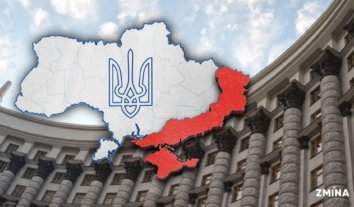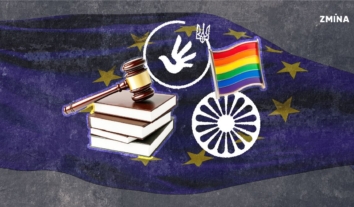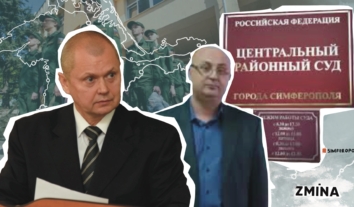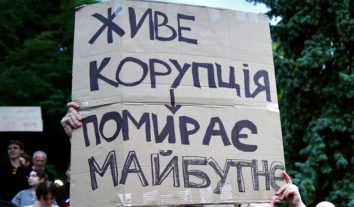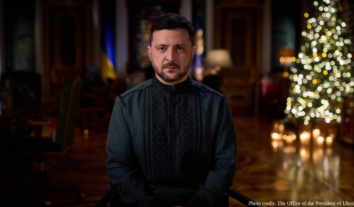How Kremlin propaganda in the occupied territories of Ukraine has changed over 10 years
The Russian-Ukrainian war, which began in 2014, was perhaps the first in which the information component was as important as the military one. The Kremlin-controlled media in the occupied territories of Luhansk, Donetsk, and Crimea, and since 2022 in the newly occupied parts of Zaporizhzhia and Kherson regions, have become a powerful and effective tool for legitimizing the illegal processes taking place there and undermining trust in Ukraine.
As early as 2015, Ukrainian television was cut off in Luhansk and Donetsk oblasts under the control of the Russian military, and there were problems with connection. Not every resident turned to the Internet for news. Television and print media were more familiar, at least for small towns.
After all, local newspapers have not yet lost their popularity and importance in the province for many people who are used to trusting the printed word. Especially if it’s not a newly created media outlet but one you’ve known for decades.
For example, Vostochny Donbas was published in the now-occupied Dovzhansk (then Sverdlovsk) in the Luhansk region. The newspaper was founded in 1938 and was called “For Stakhanov’s Tempo,” “Miner’s Banner,” “Zarya Donbassa,” etc. It reported on local events and almost switched to Ukrainian before 2014. However, after the occupation, the editorial staff remained under the “new Russian government” and started to call themselves “‘Vostochny Donbas” (VD) and began to serve the occupiers.
ZMINA traced how propaganda rhetoric has changed over the ten years of occupation of the Luhansk region and talked to media experts about narratives of Russian propaganda in the occupied territories of Ukraine, using the example of publications between 2015 and 2024.
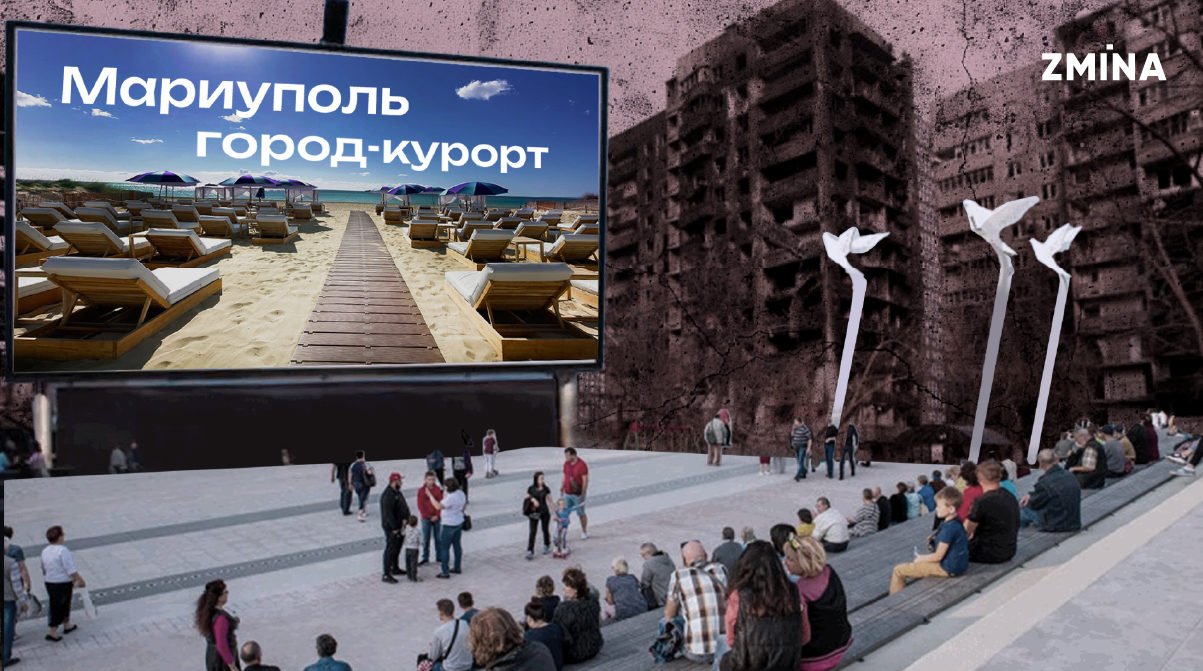
The newspaper was very cautious about reporting on the 2013-2014 Revolution of Dignity events, focusing more on economic matters. Later, when rallies under Russian flags began in the cities of the Luhansk region, including Dovzhansk, the local press began to give a brief description of the events. There was a demand for this. Most residents did not understand what was happening and wanted at least some information.
Later, armed men without insignia appeared in the city, joined by local “Cossacks” led by Aleksandr Haidey. In May 2014, it became clear that the situation in the town had changed radically and that the Ukrainian government was no longer in power. Still, it was also unclear what kind of government had come in.
By the way, the Ukrainian flag was taken down near the local executive committee, but there was no Russian flag or one of the so-called “Luhansk People’s Republic” there for a long time. Only the city flag was raised. Dovzhansk seemed frozen in anticipation: What would happen next?
At that time, there were even two heads of the city council: one legitimate, Oleksandr Schmaltz, and the other, Alexander Sukhachev, a “people’s mayor” “appointed” by the “Cossacks.”
Dovzhansk, then Sverdlovsk, was the only city where the mayor, elected under Ukrainian law, remained on the city council for several months after the occupation began.
In an interview with one of the Russian propagandists, Haidey said this:
“We don’t touch him because we need him to sign documents. We would have already “eaten” him for breakfast and lunch if we wanted to. He has never done anything in the city. So we put our person on the city executive committee. Today, our people’s mayor, Andriy Valeriyovych Sukhachev, is in charge of all the issues, and Schmaltz sits in his office scared.”
The city council dissolved on December 9, 2014, and the mayor resigned. Schmaltz explained that they had become “an illegitimate authority.”
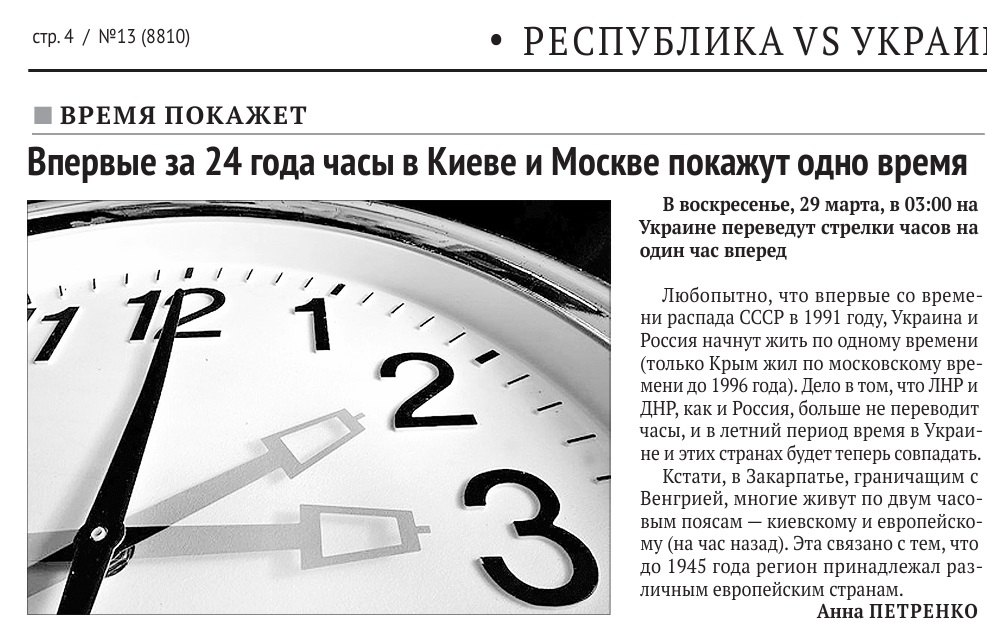 A screenshot from the 2015 VD issue. The title says, “For the first time in 24 years, Kyiv and Moscow will use the same time.”
A screenshot from the 2015 VD issue. The title says, “For the first time in 24 years, Kyiv and Moscow will use the same time.”After the so-called referendums on separation from Ukraine and “independence” held on May 11, the pro-Russian orientation of publications in the local press became very noticeable. Although initially, the rhetoric was more confusing: “Ukraine has abandoned us; Russia does not need us.”
But very quickly, Russian propagandists, following the example of the occupied Crimea (“Crimeans are a separate special community”), began working to create a similar “Novorossiya community.” The main emphasis was placed on the fraternal kinship between Donbas residents and Russians, and the slogan “Russia will not abandon us” became dominant in local press publications.
It was in 2014–2015 that propaganda narratives began to spread in local media that cooperated with the occupiers, and these narratives became “eternal.” They are still used today.
Eternal themes: “Ukrainian Nazism,” “return of historical truth,” “Russia will help us”
One of the most common narratives that has not disappeared and has even become stronger over the past ten years is “Ukraine is a puppet of the West.” The publication regularly ran articles saying that “the West will use Ukraine and give nothing in return.”
In 2014, Western countries were accused of creating and financing the Revolution of Dignity and, in 2015, of wanting to “expand its borders to threaten Russia and the young republics.”
Articles said that Ukraine was “not going to get” EU membership and that visa-free travel was about to be canceled. Every issue contained stories about how bad things are in Ukraine, while articles also described how good life is in the “republic.”
In general, the topic of “demonization” of Ukraine has been ubiquitous throughout the ten years of occupation. However, it was most aggressive in the first years of the so-called LPR/DPR. In contrast to “bad Ukraine,” the image of “good Russia” or “a young developing republic” was always drawn.
Later, the newspaper published a project called “Country 404,” or “the country that doesn’t exist.” Of course, it was about Ukraine. It lasted for several years. Its distinctive feature was its tone: sarcastic, ridiculing, humiliating Ukraine, its government, and its citizens.
The topics of “Nazism in Ukraine” and “the Great Patriotic War” are also “eternal” for Russian propagandists.
In 2014-2021, propagandists focused on themes that united Russia and Donbas, and the events of those times were described from the point of view of the Russian authorities as the only winners in that war. With the beginning of the full-scale invasion, the narrative about the heroes of the so-called “Special Military Operation or SVO” as descendants of the heroic soldiers of the Great Patriotic War became dominant in the local press.
The topic of Crimea, which has “returned home,” was not missed either.
They were also constantly trying to legitimize the new “authorities” of the unrecognized “republics”: their “presidents,” “mayors,” “tax authorities,” and “police.” There are reports of agreements with Russia, between the “LPR” and “DPR,” participation of residents of the “republics” in international competitions, appeals of terrorist leaders to the UN, OSCE, etc.
In contrast to the “hard life” in Ukraine, each issue of the newspaper published articles about the “fabulous life” in the “LPR” every year.
Closer to the full-scale invasion, the theme of the restoration of historical truth and the return of the constitutional borders of the “republics” became more common.
Throughout the ten years of occupation, the “LPR” has been building a system of new dates, a “pantheon” of new heroes – liberators from the “Ukrainian fascism.”
The topic of “returning to Russia” also never disappeared. Allegedly, by the tasks from the curators, it was weakened and then strengthened, reaching its peak in September 2022, when the Russian Federation announced the “incorporation” of the occupied territories of the Luhansk region into the Russian Federation.
Two other “eternal” topics are Orthodoxy and “patriotic education of children,” which are almost always presented in a militarized context.
New trends: less about horrors, more about revival with Russia
Strangely enough, after Russia’s full-scale invasion of Ukraine started, the local press wrote almost nothing about the fighting for a long time, strangely avoiding the topic of aggression. However, it regularly reported on the regions “liberated” from the “Ukrainian occupation,” illustrating the information only with positive examples: humanitarian aid and restoring destroyed businesses—of course, without mentioning who destroyed them. All such publications are generally held under the slogan “Only with Russia did life come here.”
The theme of the “brotherly peoples” of Russia and Donbas reinforces this. Since 2022, materials about the assistance of various regions of the Russian Federation in the development of Donbas have been regularly published.
After the “republics” became part of the Russian Federation in the fall of 2022, the local press was dominated by the theme of “reunification after the Ukrainian occupation,” stories about the regions of the Russian Federation as “their” country, that “we are with Russia forever,” and the unity of the “Russian world.”
Life in the “LPR” as part of the Russian Federation is becoming even more fairytale-like on the pages of the newspaper. And since 2023, there have been fewer and fewer references to local “leaders” and more and more to Putin. There is even a section called “He Said It Himself,” where “he” refers to the Russian president.
Also, since 2022, a new narrative aimed at young people has been promoted. Namely, the heroization of the willingness to die for Russia, often using the example of members of the Young Guard. By the way, Dovzhansk is located near Krasnodon, where, according to the book by Soviet writer Alexander Fadeev, there was a center of youth resistance to the Nazis during World War II. Therefore, the Young Guards were used as an example for young people here for many years before the Russian-Ukrainian war began. But since 2022, the topic of readiness to die for Russia has been present in almost every issue of the Vostochny Donbas newspaper.
Interestingly, from the beginning of the full-scale invasion, articles about “traditional family values” began to appear in the newspaper alongside Orthodox themes, in full accordance with the same themes and their presentation in the Russian media.
“Human Stories” and “Voice of the People”
To increase the credibility of the information presented in the newspaper, such formats as “Human Stories,” “Voice of the People,” “We are Written to,” etc., are widely used. Emotionally colored publications are more readily perceived by the reader, are more memorable, and are more trustworthy because “ordinary people say so.” As a result, all the publications, in general, are more credible.
“Divide and conquer” strategies are in high demand in propaganda
Olha Yurkova, a media expert and founder of StopFake, agrees that since the beginning of the occupation of parts of Luhansk and Donetsk oblasts in 2014 and until now, the narratives of propaganda in these territories have been changing, reflecting the evolution of the Kremlin’s goals and strategy.
For example, in 2014-2015, the narrative of the “Russian Spring” and the “civil war” in Ukraine dominated: an allegedly spontaneous popular uprising against the “Nazi and fascist junta,” which was the name of the legitimate Ukrainian government. Its purpose was to justify the invasion and occupation and to mobilize support among the population. Information measures, such as disinformation, hate speech, and physical intimidation, were used to promote it.
This narrative was reinforced by propaganda against Ukrainian statehood, which Russia disseminated to various audiences, including domestic, international, and Ukrainian audiences in the temporarily occupied territories. The main goal of this propaganda is to discredit all attributes of the state of Ukraine: the government, the army, reforms, politicians, any public institutions, civil society, etc.
In other words, the main target was Ukraine as a state. At the same time, propagandists also spread anti-Western narratives that Ukraine is a puppet of the West, which uses it to counter the “Russian world.”
Another message aimed at the occupied territories’ audience is “you are not welcome in Ukraine”: stories about how residents and authorities do not want to accept IDPs and do not provide them with jobs, benefits, etc. At the same time, fakes about “bad” IDPs were spread on the government-controlled territory. Russian propaganda used this “divide and conquer” technology to create a split between residents of the East and West of Ukraine, Russian-speaking and Ukrainian-speaking, etc. Thus, residents of the temporarily occupied territories were intimidated, so they would not even consider leaving for the government-controlled territories.
Starting in 2016, propaganda on the occupied territories began to emphasize the “integration” of the occupied territories into the Russian Federation’s zone of influence. The illegal formations of the LPR and DPR were portrayed as “young republics” building their statehood, and “historical,” “cultural,” and “economic” ties with Russia were emphasized. The goal was to legitimize the occupation, make it irreversible, and attract Russian resources. For this purpose, they used fakes, disinformation, and the so-called soft power – cultural events, sports competitions, and propaganda of the “advantages” of living in the “young republics.”
While before that, propaganda was more likely to shape public opinion, after Russia’s full-scale invasion of Ukraine, wartime propaganda began to win the war.
First, the already well-known anti-Ukrainian narratives about “Nazism,” “fascism,” and “Western puppetry” from which the residents of the occupied territories are being “saved” by Russia through “denazification” and “demilitarization” have become much more substantial.
Secondly, the largest share of propaganda resources is made up of content glorifying the “victories” of the Russian army and discrediting the Ukrainian Armed Forces, which are portrayed as weak and always defeated while at the same time being cruel war criminals who ruthlessly kill civilians, allegedly shelling schools, using children as human shields, etc. It is common to accuse the Ukrainian Armed Forces of shelling the occupied territories when it comes to civilian targets.
Thirdly, they try to convince the residents of the temporarily occupied territories that their lives are constantly improving: they have lower prices, utilities work well, and Russia provides social assistance, unlike the rest of Ukraine, where it is getting worse, the government does not care about the people, and everyone is mobilized for war.
These messages are promoted by both the local collaborationist authorities and the media they control. Also, since the beginning of the invasion, a network of allegedly local telegram channels has been created in all occupied territories, glorifying Russia and its “improvement” of life, such as the “rebuilding” of Mariupol. Russians use the rhetoric of “historical justice” and “reunification of fraternal peoples” to justify the settlement of territories.
Territories are newly occupied, propaganda methods are time-tested
Natalia Vyhovska, a media expert at the Institute of Mass Information (IMI), is researching the telegram channels of the occupation authorities and Russian-controlled media, including newspapers. She analyzes the content and structure of the media created by the occupiers and their evolution.
She believes these processes are going quickly in the newly occupied territories, although not quite as the Russians planned.
“The occupiers planned to capture Kharkiv, Kherson, Zaporizhzhia, cities and regions in their entirety. Relatively speaking, they had already written grants for the Presidential Foundation for Cultural Initiatives and other similar organizations to receive federal money, which they planned to use to open a media network centered in Kharkiv. That is, Kharkiv was supposed to become a kind of media center for the newly occupied territories,” she says.
But after the occupiers were driven from Kharkiv and then from Kherson, the center of the propaganda structure was established in Melitopol, Zaporizhzhia region. There, the media holding, behind which is the well-known Kremlin propagandist Alexander Malkevich, is developing.
Initially, the occupiers used the existing base, for example, the TV channel, which was given to them by collaborator and infamous former Kherson mayor Volodymyr Saldo. Now, they have begun to strengthen radio broadcasting. They included “Za-radio” and “Svobodnyi Berdiansk” radio in their media holding.
“Of course, there are central Russian propaganda media that can be tuned in, etc. As for the local ones, there is the Zaporizhzhia Vesnik newspaper, which is part of the holding, and it is distributed weekly with a circulation of 300,000 copies,” the expert says.
The majority of those who run this propaganda network are imported Russians who position themselves as “Zaporizhzhia residents” who are “saving their region.”
Only young journalists work in these media outlets. At the same time, the technical staff are local collaborators, says Natalia Vyhovska, adding that over the past year and a half, Russians have significantly increased their influence on young people.
“I researched this through the initiatives implemented in the occupied territories. They are funded, of course, by the Russian federal budget, but the amounts have increased significantly.”
According to the experts, this is very powerful propaganda. In the first year of the full-scale invasion, the occupiers subtly involved young people in their initiatives. In the second year of the war, this became a full-fledged powerful strategy, particularly on the eve of Victory Day, widely celebrated in Russia.
As part of this preparation, systematic pseudo-scientific meetings, conferences, roundtables, and meetings with schoolchildren and students on countering Nazism began. It talks about how Ukraine has desecrated history and how Russia is restoring it.
Russians have been doing the same thing for years in the Ukrainian territories occupied since 2014.
The occupiers do not have to fight Ukrainian content; they have completely blocked access to it.
“You can only access Ukrainian or foreign media with a VPN. It’s quite complicated manipulations with the phone, rearranging cards, etc. Here, the question arises: How advanced are the users in the occupied territories? And how dangerous it is to have a VPN because you can be stopped on the street at any time, check your phone, and at least you will be sent to the basement.”
Therefore, we can say with certainty that there is a very tough, powerful pressure of distorted information in the occupied territories, which is gradually pushing away Ukrainians who remain there.
The expert believes that critical thinking is being suppressed, and people begin to doubt what is true and what is false. Lack of access to adequate information takes away a person’s will.
“By the way, in the first year of the full-scale invasion, there was almost nothing about the war in the occupiers’ newspapers and official media. The narrative was as follows: life began with the “de-occupation” of the territory from the “criminal Ukrainian government. The main narratives were “we are restoring, building, creating,” Vyhovska states.
Ukraine, she said, was still accused of everything in the territories occupied since 2014: “did nothing, did not provide treatment, started the war,” etc.
Only about a year later, in 2023, news began to appear about the “SVO” and how Russia was “winning on all fronts.”
Another narrative of the occupiers is “Ukraine abandoned you.” It is addressed to people with a pro-Ukrainian position, saying: “No one in Ukraine needs you; you have to become Russians, and we will take care of you. Otherwise, you will not be needed here either.”
“This is supported by demonstrative videos when a person with a pro-Ukrainian position is expelled with only a bag and walks to the government-controlled areas,” Natalia says.
So, people employed under the occupation see what will happen if they express their position.
“I also saw that the propagandists and collaborators in the second year of full-scale efforts became bolder and more confident. Previously, they did not reveal that they were working on occupation resources; their names were not in the original data, but now they do not hide their status.”
At the same time, the narrative of “Russia equals Peace and Progress” has not disappeared.
“But when you know the history of local businesses and what they were like when the full-scale invasion began, it turns out that the more powerful the propaganda, the less effective it is,” Natalia says.
Another method of Russian propagandists is to dehumanize Ukrainians: if you are a person with a pro-Ukrainian position, you are most likely a terrorist. If you’re a terrorist, you’re an enemy, Natalia describes the corresponding propaganda message.
“No one directly says that if you are for Ukraine, you are not a human being. However, the format in which the occupiers describe life in the territories controlled by Ukraine is exactly this narrative. That is, if you support Ukraine, you are not a human being, and if you are not a human being, your value is zero. In general, this is a purely Soviet approach, nothing new – a person is a cog, has no value, the collective is a force.”
According to the expert, Ukraine was not prepared for such a level of Russian propaganda power in the occupied territories. Unfortunately, there are no clear answers on how to free people from its influence.
“Of course, the distorted information space can be replaced with objective data, but I think it can be like with people who have fallen into a sect. Even when you get a person out of it, they will not be the same. It is a very complicated topic.”
What can Ukrainians do? Continue identifying propagandists, writing about them, debunking myths and fakes.
“They have to answer for everything. Faith in this supports us,” says Natalia Vyhovska.
Russians are actively training “media personnel” in the occupied territories; it is crucial for them
Valentyna Troyan, IMI representative and media expert, noted that the emphasis on the propaganda media had changed noticeably since the beginning of the full-scale invasion.
“Here is an example of the occupied Luhansk region. Since February this year, the occupiers have been trying to train their “media personnel.” There are some “blogger schools” designed for young people. The activity of young people is encouraged in every possible way because the occupiers want to create as much media as possible. Still, there are not enough people to do it,” says Valentyna.
New “media” are being created using new approaches. For example, a publication like Donbas Media hardly ever writes about the war; it mostly posts entertainment content. It also conducts surveys to understand preferences.
“And these materials are designed to create the illusion that there is life only with Russia. I watched the materials they make from Mariupol. The emphasis is on the fact that Russia is returning peaceful life to the occupied territories, they use a lot of vivid photos, write a lot about plans, about the future… For example, they are planning a park. It is not known when it will be built, but it should be beautiful. Is it positive information? Of course,” the expert describes the latest trends in propaganda in the occupied territories.
That is, while people were mostly intimidated before the full-scale invasion. At its beginning, after the occupation, they began to calm down, trying to create the illusion of a “return to peaceful life” so that these people associate their stay in Russia with peace.
Accordingly, the Russians are now investing much more money in propaganda than they did before the full-scale war and before the so-called referendum on joining Russia.
“By the way, the Russian media methods for Russians and my former Luhansk ‘colleagues’ methods are different. The media in Russia talk about what heroes Russians are, what a strong country they have, and how important it is for them to unite people. And in the occupied Luhansk region, they have always emphasized how bad Ukraine is. They have frozen at this level, and I don’t think the Russians will pull them to a new one,” Valentyna believes.
Russians are also starting to get tired of horror stories, so propagandists realize that they need to switch to something positive so as not to cause disgust with media content and unwillingness to watch, the expert says.
“They have found a way to talk about ‘good deeds’: someone drove something to someone, helped someone somehow… At least this is the trend I see in the provincial media,” the IMI representative clarifies.
It is likely that with the “accession” to the Russian Federation, common standards will be introduced in the Luhansk region: separate offices of, for example, Rossiya-24 TV channel are already being opened. They will work simultaneously with Luhansk-24, which is part of the local media holding of the LPR State Television and Radio Company.
“The latter is also controlled by Russia, of course, but the Russians did not open a VGTRK office in Luhansk for nothing. Propaganda works when it is invisible. And the media in Luhansk have been “carrying game” for many years, as they say. If approaches do not change, most locals will continue to laugh at their “news,” says Valentyna.
The State Television and Radio Broadcasting Company will also open offices in each region in the occupied territories.
The occupiers will also launch their online publication, “Novoe.Media,” with a Russian editor-in-chief in the occupied territories. So far, four centers have been announced: Luhansk, Donetsk, Kherson, and Zaporizhzhia.
“By the end of the year, we plan to open 20 local editions within this network. Its editor is Larysa Rzhondovskaya, a Russian blogger and creator of the Dear Persimmon Telegram channel,” the expert said.
The center of this media outlet, dedicated to Donbas and Novorossiya, was launched in Rostov-on-Don in April 2024.
“But the most dangerous thing is that the Russians are involving young people in cooperation, and it’s not that difficult to do, especially when you live in those circumstances. It is tough to resist,” summarizes Valentyna Troyan.
The most dangerous thing for Ukraine is the involvement of young people in the creation and dissemination of Kremlin propaganda
Yulia Harkusha, a media expert and IMI representative in the Donetsk region, also says that the most dangerous thing for Ukraine in the media sphere in the occupied territories is the involvement of young people in the creation and dissemination of Kremlin propaganda.
“The Russians know what they’re doing because it’s with the youth that you have to start,” she says.
For example, the so-called gaming and anime cultures are now being used very actively for this purpose. For example, they use interesting and understandable slang to talk about the rebuilding of Mariupol, without explaining, of course, who destroyed it.
“You can quickly and easily get young people interested in an idea, lie to them, make them believe something, and that’s it – they have the person in their hands. And if it’s also television, you’re a top if you’re on TV. In this way, the occupiers are raising a new generation of propagandists. Unfortunately, it is difficult to counteract this,” the expert summarizes.
By the way, from the very beginning, propagandists in the newly occupied territories of the Donetsk region, particularly in Mariupol, relied on television.
“Literally in the first days of the occupation, we set up the airwaves and resumed broadcasting. By the way, the Russian army did not touch the Prymorskyi district precisely because there was a TV tower there, and it survived,” says Yulia.
The occupiers brought large monitors and chairs to places where broadcasting was not yet established. In the Mangush near the village council, or Mariupol on the left bank, on Svobody Square, they broadcast their stories, the expert clarifies.
“That is, they are trying to zombify people in any way they can, attacking them as soon as they can.”
Nevertheless, Yulia Harkusha is confident that at least the lowest level of the system will be held accountable for their propaganda activities and the destruction of the Ukrainian identity of young people: collaborators who colluded with the enemy.











































































































































































